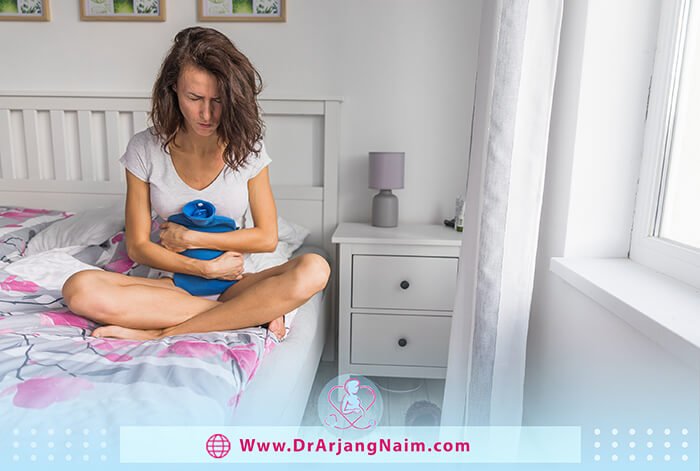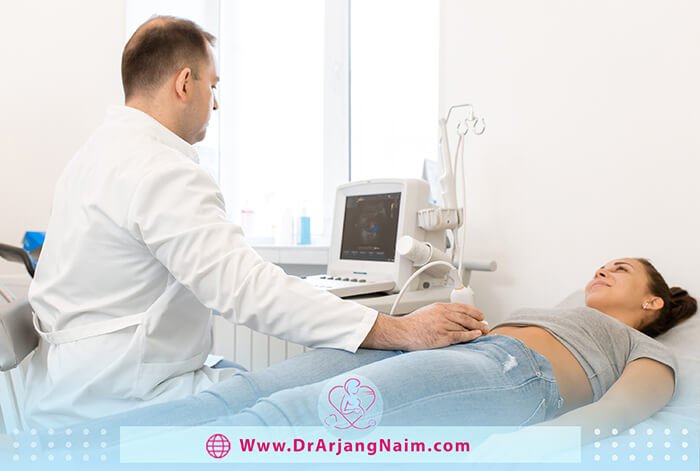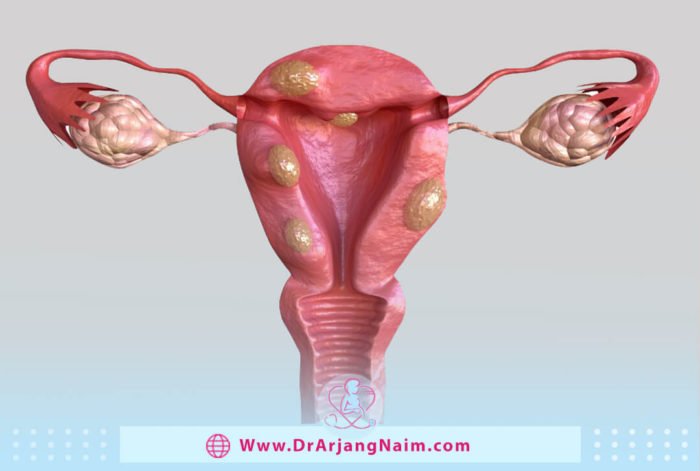Uterine fibroids, or leiomyomas, myomas, or fibroids, contain abnormal masses that grow inside a woman’s uterus. Sometimes these benign tumors may become very large, leading to abdominal pain or heavy bleeding during menstruation.
In other cases, myomas have no symptoms. These masses are usually benign and noncancerous. These myomas can grow in different parts of the uterus and are usually different sizes. Sometimes these cause pain and discomfort, but they are not usually dangerous and do not threaten a person’s life.
Early detection of uterine fibroids is very important and will be an important step in preventing future uterine removal.
Symptoms

Many women with myomas have no symptoms. In cases with symptoms, it can be affected by its location, size, and number. In women with symptoms, the most common symptoms of uterine fibroids include:
- Heavy menstrual bleeding
- Menstrual periods lasting more than a week
- Frequent urination
- Constipation
- Backache or leg pains
- Pelvic pressure or pain
- Difficulty emptying the bladder
Factors causing uterine fibroids
The exact causes of uterine myomas are not yet known. But, many factors play a role in the development of this disease:
- Genetics and family history
- Abnormal secretion of hormones
- Low progesterone levels
- Pregnancy
- Stress and anxiety
- Menopausal hormone therapy
- High body weight
Types
Fibroids can be located inside or on the uterus:
- Intramural: This type is the most common condition of uterine fibroids and occurs in the uterus’s muscle wall. Internal can grow and cause the uterus to stretch and enlarge.
- Subserosal fibroma: These uterine fibroids also form outside the uterus, and fibroma growth causes the womb to appear bigger on one side.
- Pedunculated: Subserosal tumors can create a stem, a slender base that supports the tumor.
- Submucosal: Submucosal fibroids also grow in the middle level of the uterine muscle (myometrium). These myomas form slowly. They cause menstrual cramps and a lot of bleeding.
Fibroids and pregnancy
The presence of fibroids in pregnancy can sometimes lead to problems in the child’s development or problems during delivery. Women with fibroids may experience abdominal pain during pregnancy, and there is a risk of premature delivery.
Diagnosis

Fibroids often do not show symptoms; they are usually diagnosed on routine pelvic examinations. The following diagnostic tests are:
- Your doctor can scan your abdomen or insert a small ultrasound probe into your vagina to create ultrasound images.
- MRI can determine the size and quantity of fibroids.
- Hysteroscopy uses a small device with a camera attached to the end to examine the inside of the uterus. The device enters the uterus through the cervix. If necessary, the doctor can perform a biopsy simultaneously to identify potential cancer cells in that area.
- Laparoscopy is one surgical procedure. The doctor inserts a special telescope (a narrow bar at the end of the camera) through a small incision under the umbilicus and observes the pelvic organs. The camera enters the abdominal cavity to examine the outside of the uterus and surrounding structures. If necessary, the biopsy can be removed from the outer layer of the uterus.
When to see a doctor?
If you have any of the following symptoms, see a gynecologist:
- Pelvic pain that doesn’t go away
- Spotting or bleeding between periods
- Difficulty emptying your bladder
- Anemia
- Overly heavy, prolonged, or painful periods
Treatment
Treatment for fibroids is only recommended for women with symptoms of it. If myomas do not affect the quality of life, treatment may not be necessary.
During menopause, leiomyomas often shrink, and the symptoms are often less visible or completely gone. If necessary, treatment can be in the form of medication or surgery. The location of it, the severity of symptoms, and any future childbearing plans can affect decision-making.
Medicine
The first line of treatment is medication. A medicine known as a gonadotropin-releasing hormone agonist (GnRHa) causes the body to produce less estrogen and progesterone, making fibroids smaller. GnRH agonists can cause symptoms such as menopause, including hot flashes, excessive sweating, and vaginal dryness. These medications are only recommended for short periods of time. Another option is GnRH antagonists, which prevent the pituitary gland from making follicle-stimulating hormone (FSH) and luteinizing hormone (LH). When an antagonist takes GnRH, the ovaries stop producing estrogen and progesterone. Other medications are available but may be more effective in treating larger fibroids. They are Nonsteroidal anti-inflammatory drugs (NSAIDs), Birth control pills, and Levonorgestrel intrauterine system (LNG-IUS).
Surgery
Some leiomyomas may not respond to medication, so surgical treatments should be used. Your doctor may use the following treatments:
1. Hysterectomy: A hysterectomy is a partial or total removal of the uterus. This procedure is intended to treat very large fibroids or excessive bleeding.
2. Myomectomy: The removal of myomas from the muscular wall of the uterus. This method can help women who still want to have children.
3. Endometrial ablation: Removing the lining of the uterus may be helpful if the fibroid is close to the inside of the uterus. Endometrial ablation may be an effective alternative to hysterectomy for some women with leiomyomas.
4. Uterine artery embolization (UAE), specifically uterine fibroid embolization (UFE), stops blood flow to the fibroids. X-ray imaging injects a chemical through a catheter into the arteries that carry blood to the myomas. This method reduces or eliminates symptoms up to 90% of people with leiomyomas.
5. MRI-guided focused ultrasound surgery: An MRI scan finds fibroids, and high-energy ultrasonic waves are delivered to shrink them.
6. MRI laser skin ablation: MRI scans are used to find fibroids. The tiny needles are inserted through the skin and pressurized to reach the leiomyomas. Laser light is sent through the device to shrink the fibers.
Home remedies
Some home remedies and natural remedies can have positive effects, including:
- Yoga
- Massage
- Applying heat for cramps ( Do not use heat if you have heavy bleeding)
- Appropriate diet: Avoid high-calorie foods and meat. Choose from green vegetables, green tea, and old water fish such as salmon
- Control your stress
- If you are overweight, lose weight
Prevention
Although researchers are still investigating the causes of fibroid tumors, little scientific evidence is available on how to prevent them. But with healthy choices, such as maintaining a normal weight, you can reduce your risk of developing fibroids. The following nutritional tips can reduce the incidence.
Avoid unhealthy food
You should avoid unhealthy food such as sugar, Refined grains, Trans fats, Refined oils, Processed meat, and Highly processed foods.
Healthy diet
You should base your diet on these healthy, unprocessed foods such as Vegetables, Fruits, Nuts and Seeds, Legumes, Tubers, Whole grains, Fish and seafood, Poultry, Eggs, Dairy, Herbs and spices, and Healthy Fats.
Cut back on alcohol
Drinking alcohol may increase the risk of fibroids. Because alcohol increases the levels of hormones needed for myomas to grow. Alcohol can also cause inflammation.
Losing weight
Estrogen is an important hormone for healthy fertility in both men and women. However, too much estrogen can cause leiomyomas. Many treatments are done by lowering estrogen levels. Obesity and overweight increase the risk of it. Fat cells produce more estrogen, so losing weight may help prevent or slow the growth of myomas.
Getting enough vitamin D
Vitamin D can reduce the risk of developing leiomyomas. When your skin is exposed to sunlight, your body makes this vitamin naturally. You are more likely to be deficient if you have dark skin or live in a cold climate. Supplements along with foods such as Yolk, Enriched milk, cheese, and dairy products, Fortified cereals, enriched orange juice, and fatty fish such as salmon, tuna, and mackerel can help you get enough vitamin D.
Fibroids are present for various reasons and in different sizes, but if they do not cause you symptoms, they are usually not dangerous and do not require treatment. If you are pregnant and have myomas, your obstetrician will monitor you regularly. If you have any of the annoying symptoms, be sure to see a gynecologist for treatment.
The bottom line
As the Los Angeles area leader, Dr. Arjang Naim offers the most advanced treatments for uterine fibroids. Fibroids can occur for a variety of reasons. He provides the best treatment to reduce the annoying symptoms of fibroids. Dr. Arjang Naim talks to you about the risk factors and the possibility of fibroids returning.
Additional questions
- Can fibroids turn into cancer?
Fibroids are almost always benign. Cancerous fibroids rarely occur. Doctors think that these cancers do not arise from an existing fibroid. Having fibroids does not increase the risk of developing cancerous fibroids. Having fibroids also does not increase women’s chances of developing other types of uterine cancer.
- How much fibroid causes hip pain?
Small fibroids 1 cm or less may not cause symptoms. However, fibroids 5 cm and larger may cause severe pelvic pain and heavy periods in women. Fibroids of about 10 cm and larger may cause frequent urination, constipation, and abdominal distention.
- Does massage help uterine fibroids?
Uterine fibroids, noncancerous tissue and muscle masses on the uterus, can affect fertility. Improving blood circulation through massage therapy can reduce the size and impact of these fibroids.
- Can fibroids block the intestines?
Uterine fibroids can cause other painful conditions. These growths can cause rectal pressure. If the fibroids are small, there is little pressure on your colon. If they are larger, they can completely block the intestine and cause serious constipation.
- What is the worst that can happen to fibroids?
A review of current evidence suggests that fibroid growth is variable and can range from 18 to 120 percent per year. Despite a stable hormonal environment, fibroids undergo regression, growth, and spontaneous contraction mutations outside of menopause.
References
https://my.clevelandclinic.org/health/diseases/9130-uterine-fibroids
https://www.mayoclinic.org/diseases-conditions/uterine-fibroids/symptoms-causes/syc-20354288
https://www.healthline.com/health/uterine-fibroids
https://www.medicalnewstoday.com/articles/151405
https://www.acog.org/womens-health/faqs/uterine-fibroids
https://www.healthdirect.gov.au/uterine-fibroids
https://www.webmd.com/women/uterine-fibroids/uterine-fibroids




